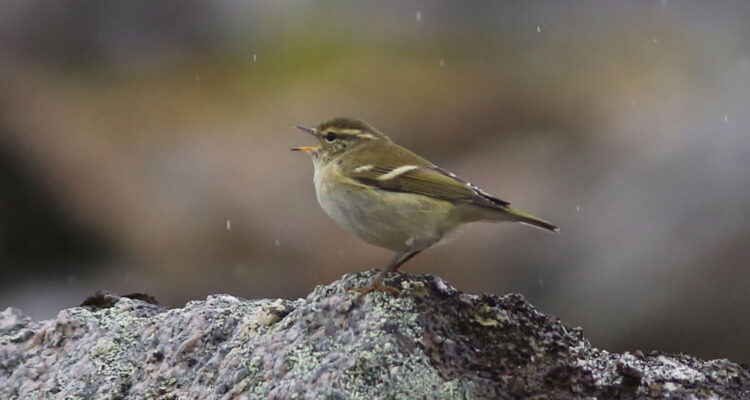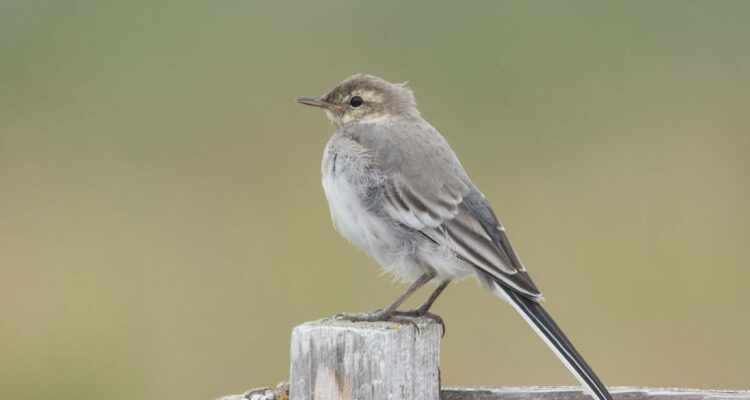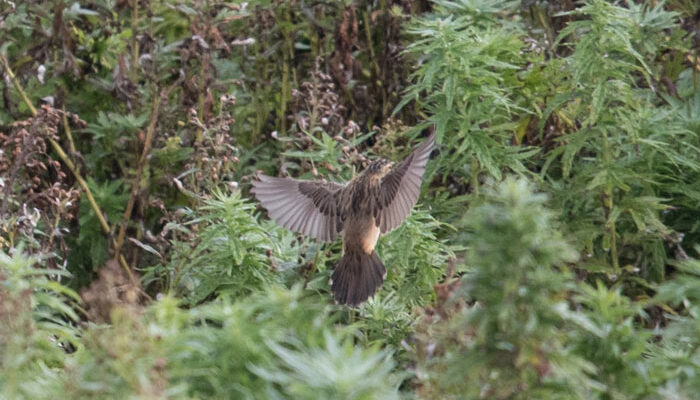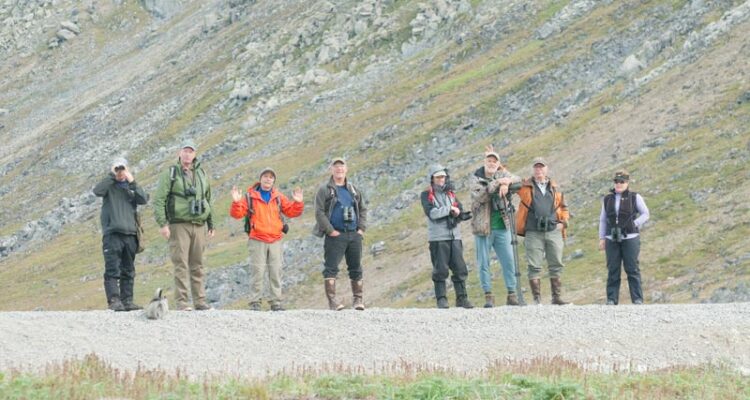It's been a great fall season for Wilderness Birding Adventures with exciting and productive trips to…

Gambell Trip Report (Aug 30-Sep 11, 2014)
Many vagrant passerines on Gambell are skulking, difficult to view creatures, but this Yellow-browed Warbler actually sang for us during its brief stay on Gambell. Photo James Levison.
Gambell with Wilderness Birding Adventures
August 30th-September 5th, with optional extension through September 11th.
The Siberian Yupik village of Gambell sits on the northwest point of Saint Lawrence Island in the northern Bering Sea. With the mountains of Russia visible on a clear day, Gambell lies closer to the Old World than the New and birders have long traveled to this remote island to search for Bering Sea specialties, and the chance for Asian migrants and vagrants. This is the report of our tenth fall trip to Gambell.
Our group arrived on August 30th to pleasant weather and light winds. Optimism was high. Unfortunately, the BROWN SHRIKE that had been found on the island the day before had not been relocated so we went straight to our accommodations, got settled in and oriented, and had a quick lunch before heading out to the bone yards. We spent the first afternoon admiring trans-beringian migrants like ARCTIC WARBLER, BLUETHROAT and WHITE WAGTAIL, the last of which is also a local breeder.
This was a group of veteran Gambell birders; everyone in our group of 12 (nine participants, three leaders) had been to the island in the past, some had been here many, many times. So most of the “expected” fall birds would not be new for the group. What followed in the next week was undoubtedly the greatest fall birding tour we have ever led to Gambell, loaded with rarities from both Asia and North America, fine camaraderie, and good weather. Let’s recap the days:
Day 2, August 31st: We enjoyed more looks at ARCTIC WARBLER and BLUETHROAT and added RED-THROATED PIPIT, EASTERN YELLOW-WAGTAIL and SHARP-TAILED SANDPIER to our trip. The first rarity of the trip came when a COMMON SNIPE (the sixth fall Gambell record) flushed from the circular bone yard.
Day 3, September 1st: The winds briefly shifted to the north today. Anticipating that this might improve the sea watching we spent some time in the afternoon at the beach and were treated to a total of 123 migrating EMPEROR GEESE. In the far bone yard we had a thrilling close encounter with a Gyrfalcon as it grabbed a CRESTED AUKLET and flew over the mountain with it. To cap off a fine day of birding, our dinner was interrupted by a radio call announcing a BROWN SHRIKE along the mountain side. We rushed right out and with some time and diligence everyone got looks of the shrike. Photos confirmed that this was a different shrike from the one found the day before our group’s arrival. These two birds are only the 3rd and 4th fall records of Brown Shrike for Gambell. As we left the shrike and headed for home the radio crackled again and we were off to see two GRAY-TAILED TATTLERS on the shore of Troutman Lake. Tired and happy we slept.
Day 4, September 2nd: The morning’s birding was pretty quiet, but a sunny afternoon stroll through the boat yard kicked up a TREE PIPIT—only the 4th North American record of pipit! This mega-rarity showed well for all birders on the island for the next four days and was a life bird for everyone in our group, leaders included!
Day 5, September 3rd: Except for the continuing Tree Pipit the birding for most of the day was pretty quiet so we spent a lot of time admiring and studying the rare pipit. As most of us were settling in for the evening, James Huntington spied an intriguing falcon on his walk back to the house around 8:30 pm. His views were brief and distant but he was bothered by the bird’s apparent small size and heavy streaking on the underparts and he roused every birder on the island to begin a search. As is usual, James’ gut feeling proved correct and after one of the most exciting chases in Gambell history (including a 10 pm group sprint across the gravel) the falcon was seen going to roost in a radio tower. In low evening light we all got very nice scope views of a EURASIAN HOBBY—the first island record!
Day 6, September 4th: We began the morning with a stake-out out the radio tower in the dark, hoping that we’d see the Eurasian Hobby still there. Indeed we did. Starting the day with choice views of this rare raptor was the perfect precursor to what would become an epic day of birding on Gambell. (Author’s note: I personally dislike, feel it is overused, and tend to avoid using the word “epic,” so it is with the full force of the intended definition that I use it here.)
After watching the Eurasian Hobby leave its perch in the dawn light, never to be seen again, a quick stroll through the near bone yard produced several Arctic Warblers, Gray-cheeked Thrushes, and Bluethroats—all of which arrived overnight. During the night the wind switched from light southwest to light southeast with early morning rain, the perfect mix for dropping birds from both directions. Our late morning sweep through the far bone yard indeed held goodies from both continents, highlighted by two rarities from Asia: WILLOW WARBLER and a singing (!) YELLOW-BROWED WARBLER (Gambell’s 5th and about the 10th for North America). Personally, this has been my most wanted bird on Gambell since we started leading our fall tour here in 2004. From North America the winds brought the first island record of ALDER FLYCATCHER, Gambell’s fourth record of TOWNSEND’S WARBLER, as well as RUBY-CROWNED KINGLET, SWAINSON’S THRUSH, ORANGE-CROWNED, YELLOW, and WILSON’S WARBLER. This was more passerines than we’d seen in the far bone yard at any one time in a number of years and it was a thrilling and odd experience to watch a mixed warbled flock containing Willow, Arctic, Yellow-browed, and Townsend’s Warbler! Paul Lehman’s sharp spotting picked out a RED-EYED VIREO, the first for Bering Sea region, but it escaped up the mountain before our group could get on it. Also, what nearly became just a footnote on an incredible day, North America’s fourth record of Tree Pipit was still showing well in the boat yard!
Day 7, September 5th: The final day of main tour. Those departing today had one last chance to scour the far bone yard for something new. Nearly all of yesterday’s birds seemed to have departed the island and our first pass through the bone yard yeilded nothing new. However, the BROWN SHRIKE from a few days ago made an appearance sat cooperatively, if not briefly, on the pump house fence. After the shrike showed off his disappearing trick, we made a second pass through the far bone yard and James Huntington turned up a very cooperative COMMON ROSEFINCH, fitting punctuation for an unforgettable week of birding. After saying farewell to our friend the lingering Tree Pipit, four of our party left on the afternoon flight. The Tree Pipit apparently left that evening as well.
Day 8, September 6th: Three very different types of rare birds were found on the first day of the extension: a confiding LESSER SAND-PLOVER fed on the shore of Troutman Lake; a LEAST FLYCATCHER (second island record) played hide-and-seek in the boat yard; and a reverse migrant CHIPPING SPARROW (the second of four for our trip) showed up in the revetments south of Troutman Lake. What makes Gambell such an exciting destination in the fall is the long and growing list of rarities that have occurred from both the east and the west. You never know what might turn up here!
Day 9, September 7th: No new rarities today, but we added ANCIENT MURRELET, and STELLER’S EIDER at the sea watch and spent several hours in the afternoon enjoying nice light for photography on the special sea birds of the Bering Sea. A brief but close Minke Whale passed by our beach this afternoon.
Day 10-13, September 8-11: The weather conspired to turn off what had been a steady stream of rarities so these last few days we contented ourselves with birding by bike to the south end of the lake, photography, sea watches, and the fine hospitality from our hosts.
We ended the main tour with 73 species, a new high total for our one-week fall trip, and added 7 more on the extension. Thanks to all of our outstanding participants who helped make this trip an unforgettable adventure!
Good birding,
Aaron Lang


